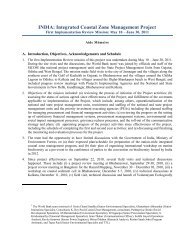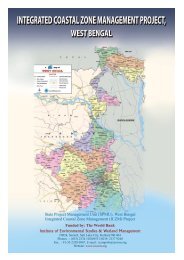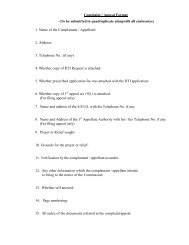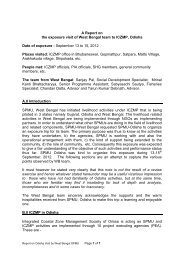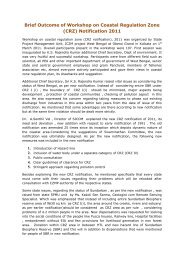Cyclone and Storm Surge - Iczmpwb.org
Cyclone and Storm Surge - Iczmpwb.org
Cyclone and Storm Surge - Iczmpwb.org
Create successful ePaper yourself
Turn your PDF publications into a flip-book with our unique Google optimized e-Paper software.
3.12<br />
3.9. Drainage scheme of Dr. B.N. Dey<br />
As a result of loss of the Bidyadhari, the only available outfall channel, drainage prospect of Kolkata<br />
became a matter of grave concern. A fresh suitable outfall channel had to be identified in the vicinity<br />
in place of the decrepit Bidyadhari river. The city had grown in the meantime <strong>and</strong> so the internal<br />
system of collection <strong>and</strong> conveyance of the drainage became woefully inadequate. Against this<br />
disconcerting backdrop, Dr. Birendra Nath Dey (1891-1963), who later became the Chief Engineer,<br />
Calcutta Corporation (1929-43) drew up a scheme incorporating augmented facilities for internal<br />
drainage, as well as a new outfall channel around 30 Km. farther east in Kultigang, a tidal creek,<br />
which ultimately flows into the Bay of Bengal via the Raimangal estuary.<br />
Kultigang which now constitutes the main outfall of Kolkata's drainage opened up much later than the<br />
Bidyadhari. In fact the former feeders of the Bidyadhari like the Nowi, Sunti <strong>and</strong> Nonagang, from<br />
North 24-Parganas, changed their allegiance to the Kultigang. The Circular-Beliaghata-Newcut-<br />
Kestopur <strong>and</strong> Bhangar Kata system emanating <strong>and</strong> catering to rapidly growing urban<br />
conglomerations join the Kultigang. The SWF <strong>and</strong> DWF channels of Kolkata Corporation including<br />
the discharge of the Tollygunj-Panchannagram outfalls into the Kultigang at Ghusighata. As<br />
urbanization continues in eastern Kolkata further volume of flow will outfall into Kultigang.<br />
The salient features of the Kulti outfall scheme are as under:<br />
From Topsia lock water is directed by gravity up to Ghushighata through a 34 km long lined channel,<br />
where it discharges into Kultigang through a sluice. This is the dry weather flow (DWF) channel.<br />
From the Palmer Bridge (also often referred to as Palmer bazaar) pumping station there is a 7.47 km<br />
long Town Head Cut (THC) drainage channel leading to the <strong>Storm</strong> Weather Flow, or SWF, channel.<br />
This channel meets the DWF channel at Bantala where there is a primary sedimentation tank to<br />
partially purify the effluents.<br />
From the Ballygunje pumping station there is a 7.163 km long storm water floe drainage channel,<br />
known as the Suburban Head Cut (SHC) which meets the THC at Bantala <strong>and</strong> flows as a combined<br />
<strong>Storm</strong> Water Flow Channel, or SWFC.<br />
The 1.829 km long storm water channel emanating from the Dhapa Lock pumping station meets the<br />
THC at Makalpota. The bottom width of the SWF channel is 36.58m <strong>and</strong> has a carrying capacity of<br />
76.47 cumec. The DWF channel is concrete lined <strong>and</strong> has a carrying capacity of 18.97 cumec. The<br />
SHC is 34km long <strong>and</strong> at Ghushighata, it outfalls into the river Kultigang through two regulators<br />
having 20 <strong>and</strong> 16 sluice gates, respectively.









